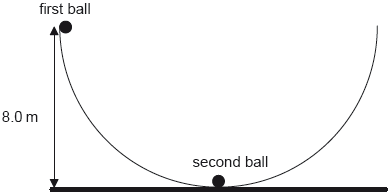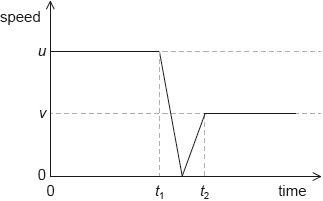| Date | May 2019 | Marks available | 2 | Reference code | 19M.2.HL.TZ2.1 |
| Level | Higher level | Paper | Paper 2 | Time zone | 2 |
| Command term | Calculate | Question number | 1 | Adapted from | N/A |
Question
A student strikes a tennis ball that is initially at rest so that it leaves the racquet at a speed of 64 m s–1. The ball has a mass of 0.058 kg and the contact between the ball and the racquet lasts for 25 ms.
The student strikes the tennis ball at point P. The tennis ball is initially directed at an angle of 7.00° to the horizontal.
The following data are available.
Height of P = 2.80 m
Distance of student from net = 11.9 m
Height of net = 0.910 m
Initial speed of tennis ball = 64 m s-1
Calculate the average force exerted by the racquet on the ball.
Calculate the average power delivered to the ball during the impact.
Calculate the time it takes the tennis ball to reach the net.
Show that the tennis ball passes over the net.
Determine the speed of the tennis ball as it strikes the ground.
A student models the bounce of the tennis ball to predict the angle θ at which the ball leaves a surface of clay and a surface of grass.
The model assumes
• during contact with the surface the ball slides.
• the sliding time is the same for both surfaces.
• the sliding frictional force is greater for clay than grass.
• the normal reaction force is the same for both surfaces.
Predict for the student’s model, without calculation, whether θ is greater for a clay surface or for a grass surface.
Markscheme
✔
= 148 «N»≈150«N» ✔
ALTERNATIVE 1
✔
«» ✔
ALTERNATIVE 2
✔
«» ✔
horizontal component of velocity is «» ✔
«»«» ✔
ALTERNATIVE 1
uy=64sin7/7.80«ms–1» ✔
decrease in height = 7.80 × 0.187 + × 9.81 × 0.1872 / 1.63«m» ✔
final height = «2.80 – 1.63» = 1.1/1.2«m» ✔
«higher than net so goes over»
ALTERNATIVE 2
vertical distance to fall to net «=2.80 – 0.91» = 1.89«m» ✔
time to fall this distance found using «»
= 0.21«s» ✔
0.21«s» > 0.187«s» ✔
«reaches the net before it has fallen far enough so goes over»
ALTERNATIVE 1
Initial KE + PE = final KE /
✔
«» ✔
ALTERNATIVE 2
«» = 10.8«» ✔
«»
«» ✔
so horizontal velocity component at lift off for clay is smaller ✔
normal force is the same so vertical component of velocity is the same ✔
so bounce angle on clay is greater ✔
Examiners report
At both HL and SL many candidates scored both marks for correctly answering this. A straightforward start to the paper. For those not gaining both marks it was possible to gain some credit for calculating either the change in momentum or the acceleration. At SL some used 64 ms-1 as a value for a and continued to use this value over the next few parts to the question.
This was well answered although a significant number of candidates approached it using P = Fv but forgot to divide v by 2 to calculated the average velocity. This scored one mark out of 2.
This question scored well at HL but less so at SL. One common mistake was to calculate the direct distance to the top of the net and assume that the ball travelled that distance with constant speed. At SL particularly, another was to consider the motion only when the ball is in contact with the racquet.
There were a number of approaches students could take to answer this and examiners saw examples of them all. One approach taken was to calculate the time taken to fall the distance to the top of the net and to compare this with the time calculated in bi) for the ball to reach the net. This approach, which is shown in the mark scheme, required solving a quadratic in t which is beyond the mathematical requirements of the syllabus. This mathematical technique was only required if using this approach and not required if, for example, calculating heights.
A common mistake was to forget that the ball has a vertical acceleration. Examiners were able to award credit/ECF for correct parts of an otherwise flawed method.
This proved difficult for candidates at both HL and SL. Many managed to calculate the final vertical component of the velocity of the ball.
As the command term in this question is ‘predict’ a bald answer of clay was acceptable for one mark. This was a testing question that candidates found demanding but there were some very well-reasoned answers. The most common incorrect answer involved suggesting that the greater frictional force on the clay court left the ball with less kinetic energy and so a smaller angle. At SL many gained the answer that the angle on clay would be greater with the argument that frictional force is greater and so the distance the ball slides is less.




